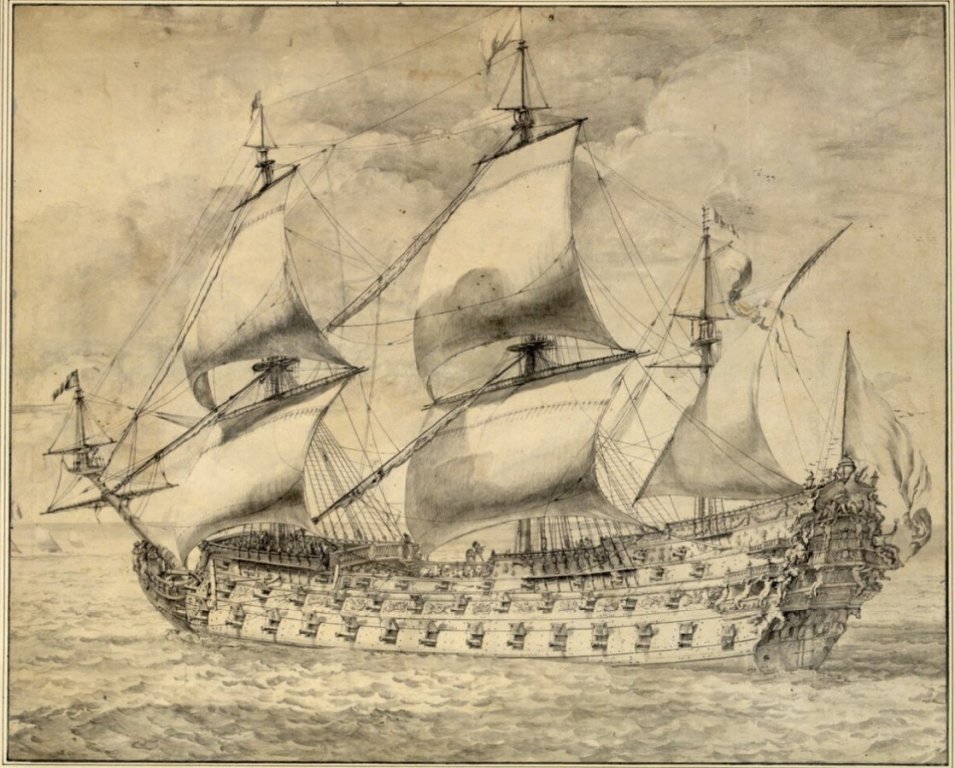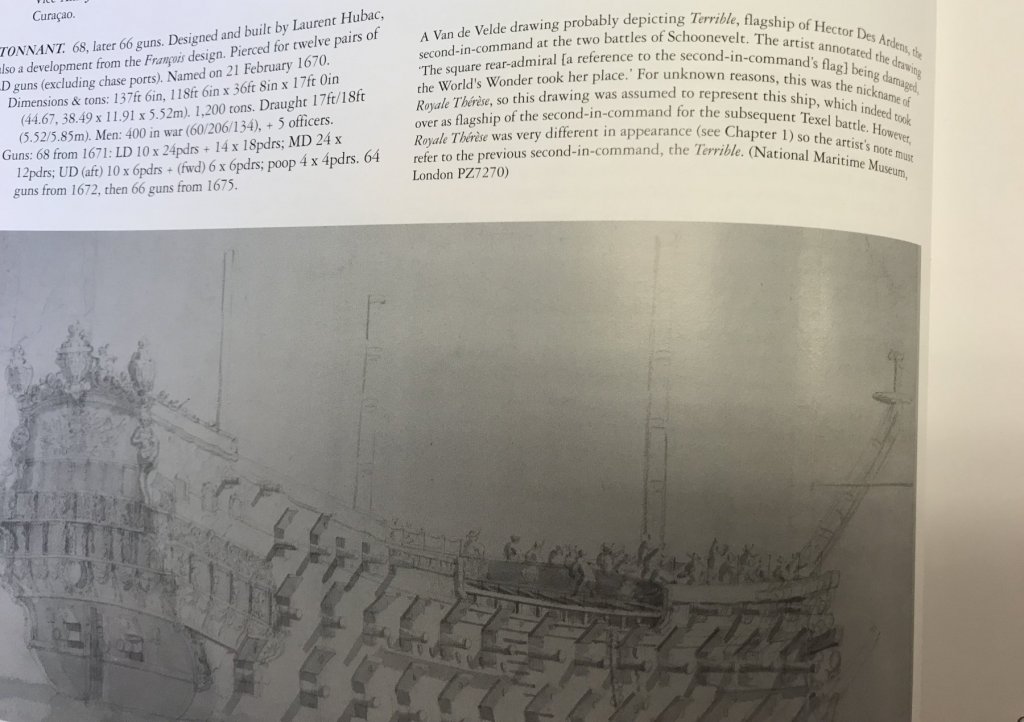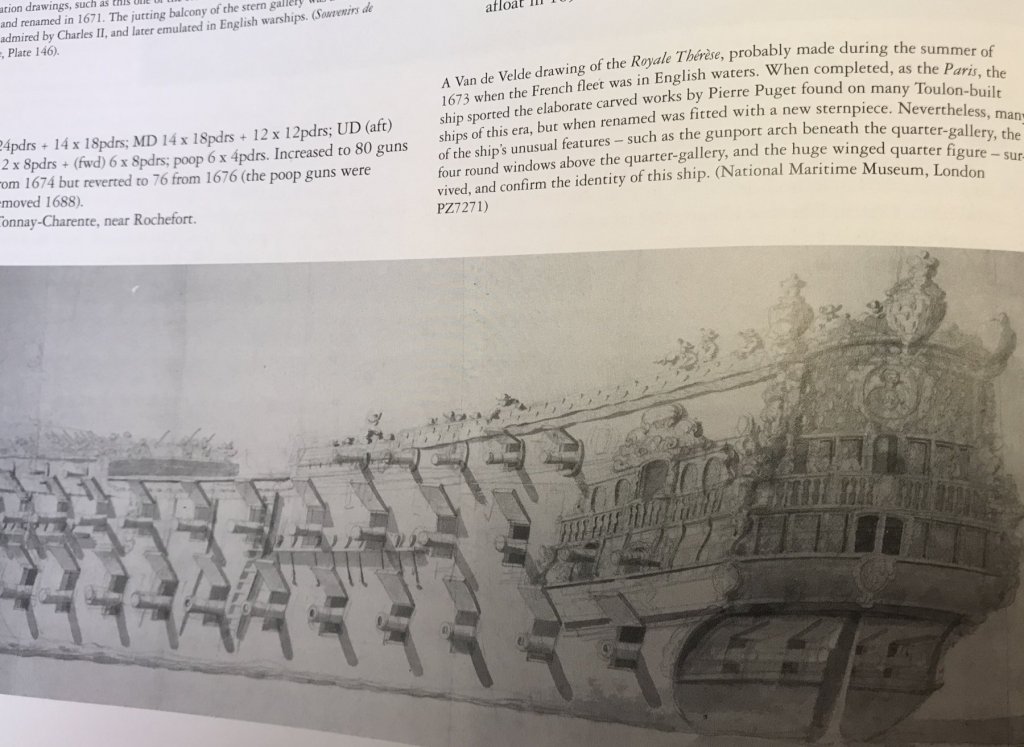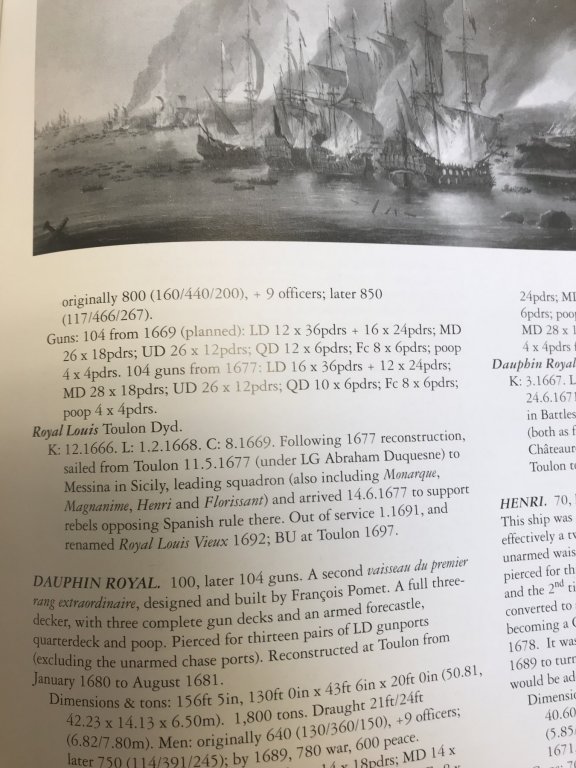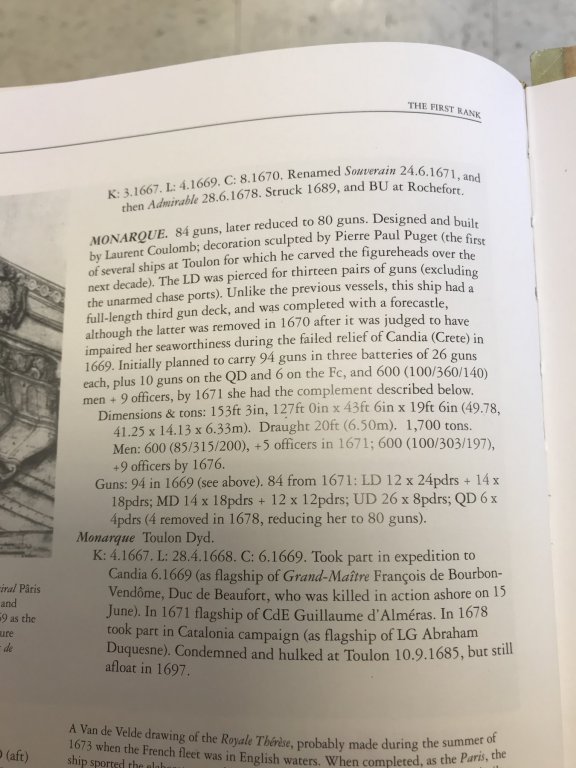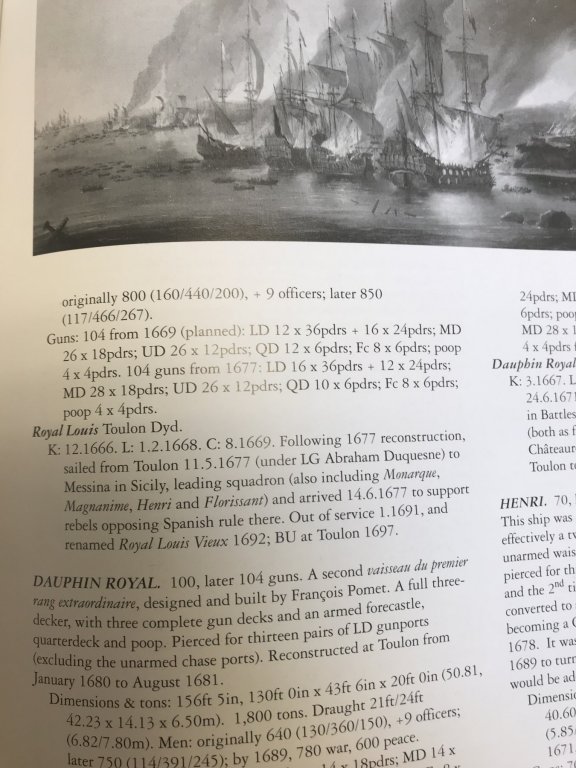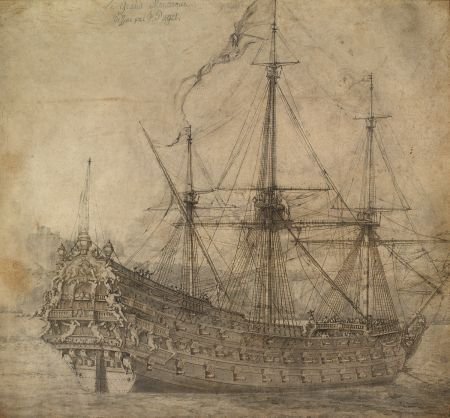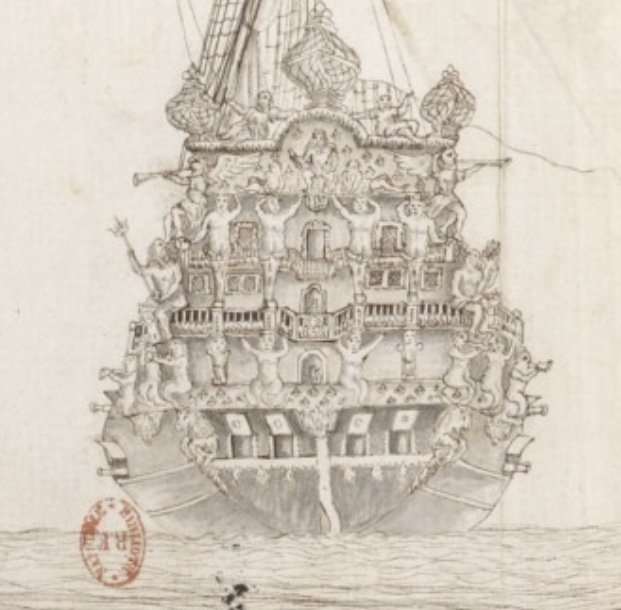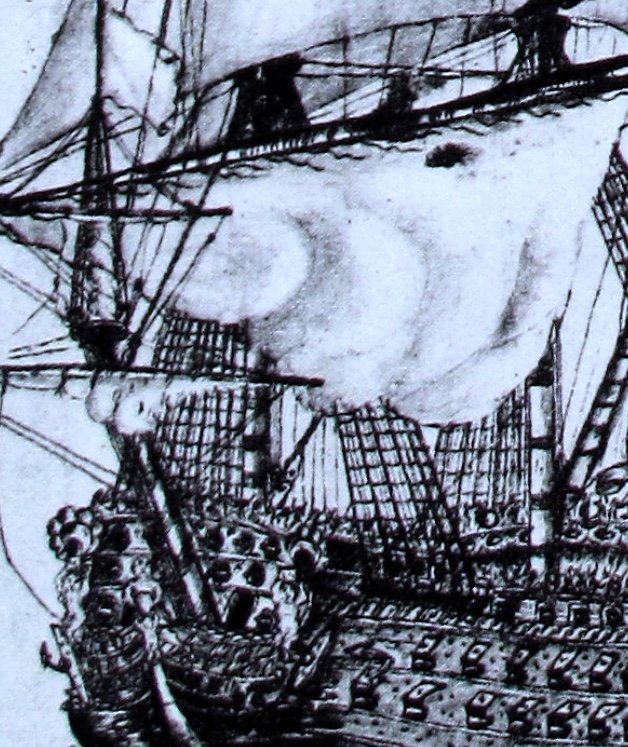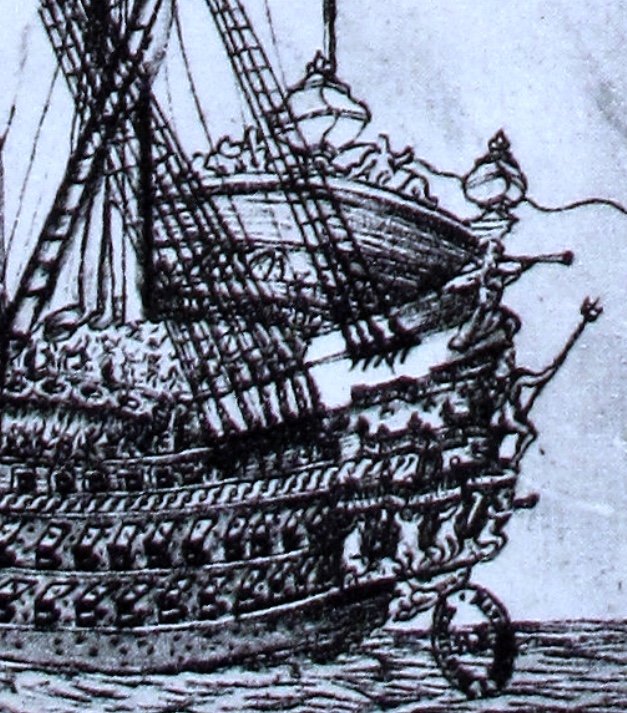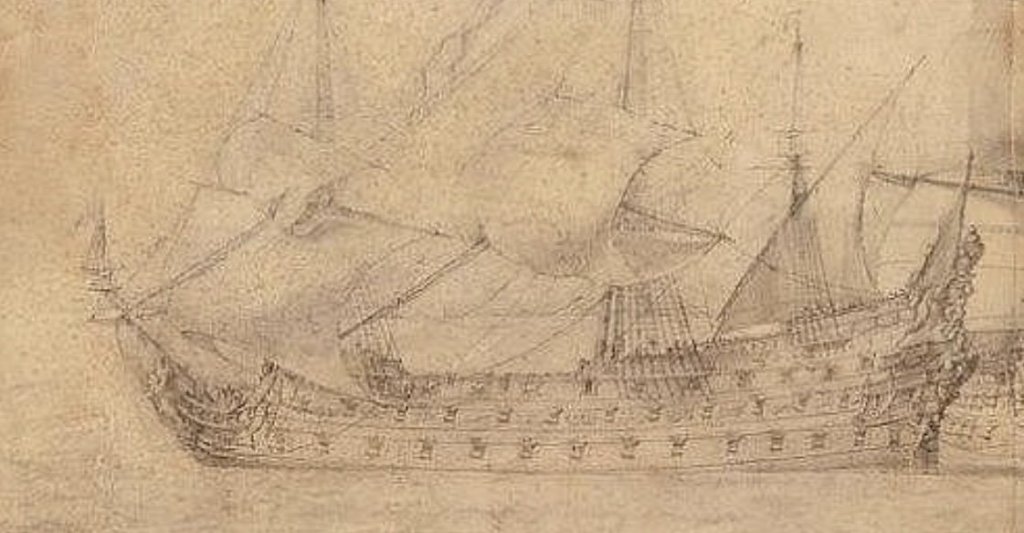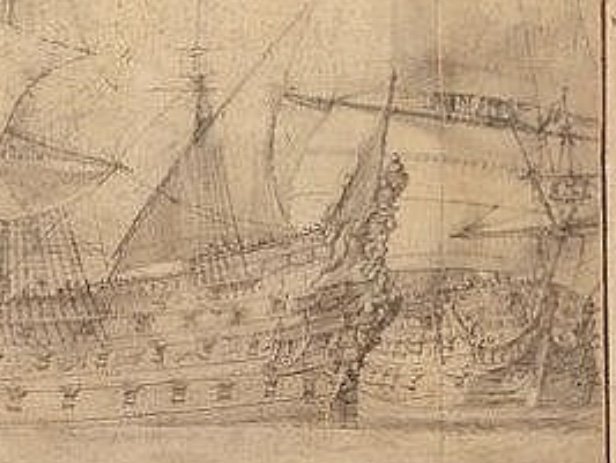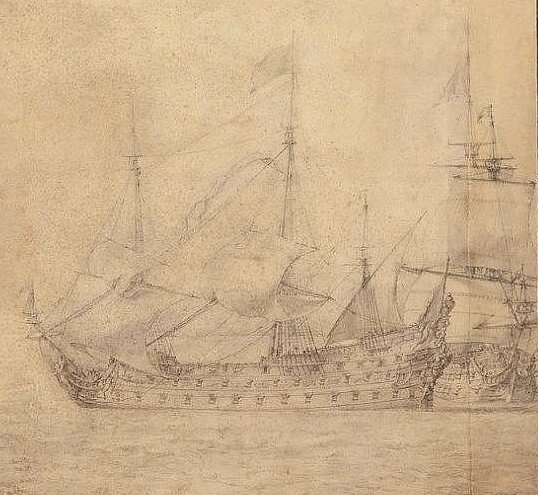-
Posts
3,305 -
Joined
-
Last visited
Content Type
Profiles
Forums
Gallery
Events
Everything posted by Hubac's Historian
-
This is going to be EPIC. I can’t wait to see how this develops, Heinrich!
- 244 replies
-
- heller
- soleil royal
-
(and 1 more)
Tagged with:
-
That’s quite a build, there, Vic - although it would seem your rowers received some pretty rough treatment, in the painting process; it’s a wonder they can sit at all after that! I just went through the link to ModernNight’s Flikr page on French ships. There are some real VDV gems in there, for sure. Thanks, again, to Kirill for providing the link! Merry Christmas!
- 2,699 replies
-
- heller
- soleil royal
-
(and 9 more)
Tagged with:
-
Heinrich, thank you so much for your generous compliments! Your consideration of the Heller kit is an interesting one. There is a modeler here, Cedric, who is in the process of converting the Heller kit into La Reine. He is quite busy, in life, and has not been visible for a while, but his research is quite fascinating, and highlights many of the practical difficulties of converting a model of a particular ship - Soleil Royal in 1:100 scale - to her kissing cousin - La Reine, which was actually slightly smaller in full size, and consequently, the scale of the model must reflect that. Very tricky! Cedric has made an excellent start of it, and his build-log can be found here under his screen name, CedricL. I highly recommend checking it out. That being said, I do not think the Heller kit is suitable to convert to the Monarque/Royal Louis. Le Saint Philippe, on the other hand, is a highly plausible alternative, in my opinion. There is very much in the Heller kit architecture to recommend this approach. To answer your question about the lower hull, though, I am really captivated by this idea of creating a super realistic diorama, with my ship in a sea - at port of Brest, on the Penfeld. To me, the lower hull of the Heller kit is really problematic, and I just prefer to cut it away altogether.
- 2,699 replies
-
- heller
- soleil royal
-
(and 9 more)
Tagged with:
-
Welcome aboard, Jose! Thank you, I’m so glad that the project interests you. Well, the St Philippe monograph is my Christmas present, but it has been in transit for almost a month now. Perhaps it is sailing over here on Le Saint Philippe II 😉 For clarification, we had an “early” Christmas on Saturday, at home in New York because we flew down to Florida to be with family for the actual holiday. That’s why I know my big present hadn’t arrived. In the meantime, though, I’ve been browsing photologs from the Rochefort conference and this page has a ton of really good pics of the two models made for the monograph: http://www.modellmarine.de/index.php?option=com_imagebrowser&view=gallery&folder=rochefort18-3&Itemid=55 Thanks to Kirill for providing this link! One model is fully rigged, and the other is in the admiralty style. Right away, I can see how helpful this new resource will be for correctly outfitting the decks and resolving certain issues I am bound to encounter in the poop deck/poop royal deck from lowering the sheer. But the greatest advantage, for the model I’m building now, is the masting and rigging. I think it is reasonable to rig SR of 1689 to a 1693 scheme. So, anyway, this is a slow-moving monster, but things are starting to happen.
- 2,699 replies
-
- heller
- soleil royal
-
(and 9 more)
Tagged with:
-
Thank you, Kirill. I am debating whether to make a rope walk for the Soleil Royal project, but I have time before I am anywhere near that decision. I am also considering buying line from Chuck Passaro, but I suspect it would be significantly less expensive to make my own. So, is this Guttermann line polyester?
- 228 replies
-
- spanish galleon
- lee
-
(and 1 more)
Tagged with:
-
Kirill, This is so beyond the beyonds that I am almost speechless. Almost! I love everything about what you have achieved, here, and am completely astounded by your rigorous attention to detail, and the superb results you have achieved throughout; your weathering, your ornamental/heraldic additions, your masting, sails, rigging. The natural lay of your rope coils, and the perfect interplay of taught and slack between the standing and running rigging. It is all truly magnificent and evident of an unwavering commitment to a standard of excellence. I will be re-visiting this build over and again, and I will be PM'ing you for particular advice on rigging cord, sails and the like. I sure am glad that you came out of the woodwork, so to speak 😏
- 228 replies
-
- spanish galleon
- lee
-
(and 1 more)
Tagged with:
-
Welcome, Kirill! I am very glad that you have found the project of interest, and the information useful. I try to update what I’ve learned, as my understanding of period practice improves. I look forward to seeing your model develop, when the time comes to get her started. Thanks to everyone for your likes, comments and looking in. Happy Holidays, everyone!!
- 2,699 replies
-
- heller
- soleil royal
-
(and 9 more)
Tagged with:
-
Hello, Chapman. Thank you for returning to this subject of the Royal Louis. And, Druxey, yes the primitive port quarter and stern drawings do agree well with each other. What I should have mentioned yesterday is that I am not completely discounting this German analysis of the RL/Monarque’s carved works. Both ships were named for and celebrate the munificence of Louis XIV. Although it will require a lengthy transcription into Google Translate, I do still plan to buy the book because I would like to better understand the allegory, and hopefully gain a better appreciation of the working relationships among LeBrun, Girardon and Puget. My point in drawing the comparison was simply that few sources are unassailable - unless written by the principle actors, in the time period in question. Pepy’s Diary, for example, is a pretty open window into his life and ship-building times. In the 21st Century, on the other hand, we are tasked with sifting through a variety of primary and secondary (academic) sources. Even among the highly regarded experts - there often appear discrepancies between ship attributions, histories, armaments, etc. I will first illustrate this point using the following captioned images from Winfield and Robert’s book, concerning the Terrible vs. Le Royal Therese. Hopefully, the captions are legible: Now, in a very highly regarded (by me, especially) book that explores the First Marine in depth, this portrait, as well as a less detailed port broadside view of what appear to be the same ship, are labeled as the Royal Therese. However, W & R’s explaination of why this was likely the Terrible, and not the RT, reveals a step further in analysis. In my opinion, then, the attribution seems more likely correct that this is the Terrible. And, then, I feel even more strongly so, when I see this captioned image of the Royal Therese, also from W & R: The particulars of this portrait correspond with numerous other citations of the RT, that I have seen, and agree also, among the aforementioned particulars of the stern and quarter galleries, with a well-circulated portrait of Le Paris, as she originally appeared. So, as my sources improve, the quality of my educated guesses improve, though - of course - little that I am saying is irrefutable fact; I’m just an amateur, really. Returning to the Monarque, following is W & R’s caption describing her early particulars: Now, allowing for certain discrepancies in the following picture (as drawn vs. what is described above) that I believe to be the Monarque, and making an assumption about the presence of four chase guns pierced through the beakhead bulkhead - at most, the description and the ship pictured below could only carry 94 guns. This would place her beneath the Premier Rang Extraordinaire, of which the RL definitively belongs. W & R make mention that the Monarque was intended to have an armed forecastle, but the picture below would seem to indicate that she did not. Also, the portrait must date to a time just after her launching because, by 1670 her forecastle is removed. This portrait shows 15 piercings on the lower deck (including an armed chase port), as opposed to the 13 intended pairs mentioned above, in addition to the chase port. Despite these artisitic discrepancies, I still only count 94 guns, if I exclude the lower deck chase port and add in 4 beakhead bulkhead guns on the middle and main decks. It is primarily on the basis of armament, in addition to the agreement between this portrait and the starboard quarter portrait that is labeled the Grande Monarque, that I believe this ship to actually be the Grande Monarque. Now, consider below, the W & R description of the RL of 1669: There is specific mention of the forecastle armament (8 6lb guns), and the poop (4 4lb guns). At any point in her career, the RL would have been more heavily armed than the Monarque, and I imagine that any portrait of her would reflect it. Anyway, that is why I think what I think, but I remain open to the possibility that this German title might change my mind, or some other, future source may paint a clearer picture. As always, thank you for your interest and your thoughts and for pushing this conversation forward. It is greatly appreciated! Chapman - you mention that you are researching Puget’s work for a project concerning La Reyne. Are you planning a model of her?
- 2,699 replies
-
- heller
- soleil royal
-
(and 9 more)
Tagged with:
-

HMS VICTORY 1765 by albert - 1/48
Hubac's Historian replied to albert's topic in - Build logs for subjects built 1751 - 1800
I will gladly sign-on for this one. You are off to a marvelous start, Albert! -
So, I’ve been thinking about this German language study of the Royal Louis of 1668 that was recommended to me by Chapman. As I commented, earlier, I found it really difficult to find any material difference between the German book cover art closeup of the “Royal Louis’s” stern and a known and inscribed portrait of Le Grand Monarque, par Pierre Puget. Here are a couple of screen shots of the German book: Now take a close look at the Monarque below. At the top, just off the center, left, is the inscription incontrovertibly identifying the ship as the Monarque. Now zoom-in on the stern, and count the number and arrangement of bolts beneath the stern chase ports; look at all the little details of the ship, as well as the shading around the lanterns, and the undulations of the water. Really look closely. The reason I can see no difference between these two portraits is that there is no difference. The German cover art is simply a cropped enlargement of this portrait of the Monarque. It would seem that the authors have mis-identified their subject. This can be confirmed by the fact that this larger picture of the Monarque has an un-armed forecastle, however the RL of 1668 would have had an armed forecastle. Incidentally, the port broadside picture of the Monarque that I have been posting, recently, also is unarmed in the forecastle, and yet it is often mis-identified as being the Royal Louis of 1668. It is interesting to note, BTW, that the stern chase ports in the Puget drawing of the Monarque are shown unarmed. Now, look at the following pics of a primitive contemporary drawing that is always attributed as the Royal Louis of 1668: Because of the primitive nature of these drawings, it is difficult to guage how many grains of salt one should take with them, but there are differences in the number and arrangement of figures. And, yet, there are many similarities. The architecture and overall aspect of the stern would seem to be very close to the Monarque’s. Notice, also, that the armed forecastle is clearly visible, off the port bow. I don’t want to seem ungrateful to Chapman, for the reference, because, really - I do appreciate the suggestion. Unfortunately, for our German friends, this does not appear to hold up. I’m not really sure what the RL of 1668 looked like, but I would not be surprised if she were very similar to the Monarque. Murky waters, here. Tres murky.
- 2,699 replies
-
- heller
- soleil royal
-
(and 9 more)
Tagged with:
-
Yeah, EJ, I’m feeling you on the clay issue. Pretty soon I’m gonna give it a go, but I’ll experiment with a larger figurative carving. I think it might be really tricky to master these new skills on small ornaments like fleur-de-lis. I also like the eyebolt method, Dan, and I think that is definitely the way to go.
- 2,699 replies
-
- heller
- soleil royal
-
(and 9 more)
Tagged with:
-
I like the idea of a stamping block. It’s a bit of a trick to get all of your block points to index in exactly the same plane. Might be worth a go, though. Thanks for the tip, Dan!
- 2,699 replies
-
- heller
- soleil royal
-
(and 9 more)
Tagged with:
-
Well, I am on a hot streak of finding really cool, contemporary ship portraits that I had previously never seen before. Here’s a portrait of a first rate that is attributed to Pierre Puget, from 1676. Again, it is too fuzzy to read for detail, and it may just be a general portrait of a first-rate that may or may not have actually existed. Whatever the case may be, it is interesting for a variety of reasons: One thing that really jumps out at me is the pronounced rake of the main mast. It seems that this feature, which shows up in earlier portraits, is greatly reduced as construction trends close out the 17th Century. The heraldic band of arms between the middle deck ports matches what we see on the Monarque - in their presence and placement, if not their detail. The stern balconies are hard to read for their arrangement, but it looks as though you have a lower (middle deck) stern balcony, supporting a main deck balcony. The lower balcony could be a false balcony, though, but it is hard to read for detail; looks shallow, though. Also, the high sheer and ballustraded quarter galleries seem to be characteristically representative of the early First Marine. Those might be Puget’s signature horsehead sculptures at the lower finishing of the QGs. Maybe not. No idea what ship this is, really, but it’s interesting. Also, cool to have a bow view, to the side. This view offers a decent perspective of the earlier headrail arrangement. I have to say, I’ve come to view Puget as being on a par with the VDVs, when it comes to ship portraiture.
- 2,699 replies
-
- heller
- soleil royal
-
(and 9 more)
Tagged with:
-
I certainly agree with your insights, EJ, particularly regarding the availability of munitions/guns, and a captain’s preferences as they relate to ship handling. Excellent insights!
- 2,699 replies
-
- heller
- soleil royal
-
(and 9 more)
Tagged with:
-
Well, Dan, my plan is to devise the most remarkably tedious process and to follow through on that, ergo... Using the thinnest styrene sheet I have, I will scribe the layout for two strips that match the width of the upper and lower port lids. Each strip will then be equally divided, along its length, and another two plank lines will be scribed-in so that the linings each look as though they consist of three equal-width planks. Next, using my try-square I will measure and scribe a series of lines that represent the lid lining height, which is slightly less than their width on the Heller model. Later, I will use these lines to part the lids from each other with a straight chisel. But, first, the really fun part: I will chuck a sewing needle (made of better steel, more rigid and sharper than a common pin) into a pin-vise and make just enough of an impression in a diamond-hatch pattern of lines, maybe five or six lines per lid (let’s just say 2 lines per plank), and so that none of the nail impressions comes too close to the border of each lid lining. The diamond-hatch pattern is what makes the detail convincing. This seems incredibly tedious, and IT IS, but I am reminding myself that there are only going to be 60 of these to do. Unfortunately, I think one would need a swiss watch gear to mount a daisy wheel that you could roll in straight lines to make your impessions easily, and even then - it’d be a trick to get the lines to alternate in a diamond-hatch pattern. Next, a light swipe with an emory board to level any mounding of the plastic, around the pin impressions, and then - the big decision: whether to paint before mounting the ornaments. Painting before ornaments would make it tremendously much easier to distress wash the lids (so that your hundreds of pin pricks show), and it would also mean that I could easily paint the ornaments flawlessly gold. And, just wait til you see this gold paint I found; it’s an Academy (I believe, but I looked at a lot of gold paints and brands are blurring in my head) artist acrylic that looks like slightly patina’d, 24-Karat old gold, that still has a lustrous warmth to it. I wanted to capture the golden impression that Bakhuizen makes in his Battle of Barfleur painting. It’s going to look dynomite! So, painting first would be much easier, and then I could just cyano the ornaments over the paint - something I almost never do - but this joint isn’t doing any work, so it should be fine. Then, finally, part the lid linings. Retouch the edges. And then I have to figure out how to make really tiny rings out of the appropriate guage of annealed wire. Any thoughts on that? The rings need to be, like a heavy 1/32”, 3/64” (at scale, if an 1/8” = a foot, then a 1/16” is = 6”, so you want to end up somewhere around 4”, scale. TINY. Muse away, my friend!
- 2,699 replies
-
- heller
- soleil royal
-
(and 9 more)
Tagged with:
-
Tres interessant! Well, as you say, that is a whole other realm of confusion that I will soon enter into. I don’t have ready access to the rest of the kit, at the moment, but I will when I visit my Dad in January. When I do, I’ll bring back my gun barrels and port lids. Progress on the actual model has slowed quite a bit because I haven’t had anything easily transportable that I can take to work with me for breaks. I plan quite a bit of detailing for the inside surfaces of the port lids: alternate direction lid linings with nailing detail, rings and lanyards for closing, and fleur de lis for the lower battery lids and shells for the upper battery lids. Sometimes, I see two rings in contemporary drawings for the interior lanyard, but more often I see one, so that is what I am going with. I was making good progress on scraping the lower hull, for painting, but I am in full holiday swing, at the moment, and nothing is really happening right now.
- 2,699 replies
-
- heller
- soleil royal
-
(and 9 more)
Tagged with:
-
Hey Mark! Thanks for weighing in. Your point about ventilation makes good practical sense because, more often than not, it was rot that sealed these ships’ fate at the wrecking yard, as opposed to the enemy line of fire. I have to ask you, though, what are bucklers?
- 2,699 replies
-
- heller
- soleil royal
-
(and 9 more)
Tagged with:
-
A few notes on armament, according to Winfield and Roberts. Prior to 1693, the practice of piercing an unarmed bow chase port on the first battery was common. For Soleil Royal, upon completion in 1670, this amounted to 15 armed ports, per side that were a mixture of 36 and 24-pound guns. The book does not make it explicitly clear, but my presumption is that the heavier 36-pound guns would be placed forward, over the fullness of the hull, and the somewhat lighter guns would be placed aft. After 1693, piercing for the chase port ceases out of concern that it unnecessarily weakens the bow structure. Presumably the chase ports in the forecastle provide sufficient forward fire power. Another insight from the book is that, despite artisitic and modeling conventions that often show the stern chase ports armed, in practice like the bow chase ports, they would only be armed when needed; the aft two guns, per side, would be shifted into position. This makes practical sense when you consider the working room and recoil allowances that would be necessary for safe operation of the broadside guns. If this is true for the bow, where the turn of the deadwood into the stem creates intersecting recoil paths between the bow chase gun and its next neighbor aft - then it is an even more acute problem, at the stern, where the guns are perpendicular to each other. The other point of note is that SR and Royal Louis are often assigned a “notional” rating of 120 guns. I suppose this accounts for the maximum possible armament, if all chase ports were armed, and perhaps, if you added another four guns between the forecastle and quarter decks. As that served no practical purpose, however, the actual armament tended to be significantly less. With all of that in mind SR’s initial armament would have amounted to 106 guns, distributed accordingly (W & R, pg 60): LD: 16 36lb guns + 14 24lb guns MD: 30 18lb guns UD: 26 8lb guns QD: 10 6lb guns FC: 6 6lb guns Poop: 4 4lb guns It should be noted that on these first vessels of the Premier Range Extraordinaire, all of their guns would be bronze, as iron was not practically safe for larger calibers until after 1691, according to (W & R, pg 55). After her refit in 1689, her “notional” rating was reduced to 110 guns, however, her actual armament was 104 guns (W & R, pg 60). For a very brief time, she was experimentally armed on the LD with a mixture of 48lb and 36lb guns, however, the immense size and weight of these guns made them un-weildy for efficient operation. SR’s armament at the time of Barfleur consisted of 104 guns that were distributed, accordingly (R & W, pg 60): LD: 28 36lb guns MD: 30 18lb guns UD: 30 12lb guns QD/FC: 12 6lb guns Poop: 4 4lb guns The happy accident for me is that by scribing in a representational 15th bow chase port, my modified Heller model now has an appropriate refit lower broadside of 14 guns. The same good luck does not hold on the middle and upper deck batteries of the Heller kit, which are only pierced for 14 a side. That is, unless the middle and main deck bow chase ports are actually armed. Not sure about that. W and R only discuss the LD bow and stern chase ports. Whatever the case may be, if you count in my representational bow chase port on the LD (but exclude the four new octagonal ports on the poop deck), my Heller model could carry the notional rating of 110 guns. If W and R’s 30 gun distribution for the middle and main decks is, in fact accurate, and if it includes guns at the forecastle chase ports, then the Heller kit is closer to correct for 1689 that I previously supposed. Distribution on the quarter deck is where it gets murky; she only carried six guns on the QD, post refit? A few other interesting things to consider are that, for one, Laurent Hubac had passed in 1682, so the task of re-building her fell solely to his son, Etienne, in 1688/89. Apparently, the rot was extensive - affecting not just the top timbers, but significant portions of her hull framing, right down to her keel (W & R, pg 60). What this means is that Etienne rebuilt a virtually new ship upon the original keel. I think one can only presume that enough of the original transom framing remained intact, so that the re-built SR might still exhibit the four stern chase ports as being positioned below the widest point of the transom. This presumption stems from the apparent conflict between the change in ship design where, by this time in 1688, master shipwrights would be framing the transom so that the chase ports were in line with the widest point of the transom, yet Berain’s ornamental scheme for the stern still shows the earlier 1670 transom. I am not really sure what to make of this because, if the frame bends at the transom remain the same, one must wonder whether the hull, at mid-ships was reconstructed as originally, in 1670, or in a more contemporary (to 1688) form that was then faired into the old transom. This question takes on more significance when one considers that Etienne petitioned the king aggressively, in 1692 (following the loss of SR at Cherbourg, and subsequent orders to re-build her), to convert his Foudroyant (newly on the stocks) to the replacement SR. Apparently, Etienne still had the framing moulds (W & R, pg 67), and while the new SR was dimensionally larger (5 1/5’) than her predecessor, this implies that Etienne would have framed the new ship much as he did, the rebuild SR in 1689. Apparently, also, the lower battery was still armed for 14 a side. I don’t necessarily think there are answers, here, but the questions are interesting, nonetheless. For my part - and thinking about a future full scratch-build of SR, 1689 - my preliminary thinking is that the recently published (J.C. Lemineur) framing of the St. Philippe of 1693, is probably a sound basis for creating a framing plan of SR. A ship re-built in 1688 would probably have been architecturally very close to a ship built new in 1693, or so I suppose. As yet, though, I have not seen that monographie and have no informed opinion about it.
- 2,699 replies
-
- heller
- soleil royal
-
(and 9 more)
Tagged with:
-
THE CORRECTIONS A few posts earlier, I was delighted to discover a picture of L’Orgueilluex in Rif Winfield and Robert’s new book French Warships in the Age of Sail 1626-1786. Here is what I said on the matter: “In a previous post, I had noted that I had no photographic record of Le Orgueilleux. Well, that’s because the above vessell is always labeled La Superb. According to Winfield, though, that is a mis-attribution. Apparently La Superb and L’Orgueilleux are sister ships and this vessel pictured is the latter. So, it is very dicey, indeed, trying to ascertain what is what in the murky First Marine. With that discovery, though, the similarities between both Hubac-built ships, La Reyne and L’Orgueilleux become ever more apparent:” Well, that’s great and all, as it relates to the picture of L’Orgueilleux, but I am wrong in assuming that the L’Orgueilleux pictured is the same ship that Laurent Hubac built at Brest in 1670. It is not. The L’Orgueilleux pictured actually began her career in 1670 as the Faucon. She was built in Rochefort by F. Pomet and renamed L’Orgueilleux in 1671. Her armament varied from 68 to 70, and finally 76. Her sister ship, the Vermandois, was built in the same yard, in the same year, by the same designer, and the changes in her armament also correspond. Her name was changed to La Superb in 1671. So the reason for any resemblance between Hubac’s La Reyne and these two sister ships would be purely conjectural. Perhaps, Pomet admired La Reyne and wished to emulate her in these lesser rated vessels. I have no idea really. Anyway, I apologize for the mistake, I should have waited to actually read the book before posting. In another post - when I have the book in front of me - I will detail Winfield’s discussion of Soleil Royal on launching, her refit and eventual replacement. There are a few interesting tidbits, there, that lend a little more clarity to the picture. In particular, he explains the difference between a “notional” rating for 120 guns (which she never carried) and her likely armament at different stages of her career - including the common practice in the early First Marine of mixed calibers on the three main batteries, so that some ships carried up to seven different calibers of gun. Really a great read, so far, and very insightful in terms of the evolution of the French rating system into the ships of the Second Marine.
- 2,699 replies
-
- heller
- soleil royal
-
(and 9 more)
Tagged with:
-
That sounds like a reasonable accomodation, EJ. Perhaps builders left a section of bow deadwood over-long, to one side of the stem so that bowsprit could be fayed into it? What say the experts?
- 1,035 replies
-
- royal katherine
- ship of the line
-
(and 1 more)
Tagged with:
-
I am fascinated by the Science Museum Model of the Prince. I can appreciate the practical considerations for off-setting the bowsprit to the side of the mast and stem, however, I had always thought the stem was an essential support for the bowsprit. Or, is it the case that between the gammoning and the fore stay(?) weights and tensions are balanced?
- 1,035 replies
-
- royal katherine
- ship of the line
-
(and 1 more)
Tagged with:
-
I agree with that, as well, EJ. If we simply accept that the knowledge is lost, and no one asks the question - then, we certainly will never arrive at an answer or a different view of a subject. My hope, via the internet forum, is that others will see the things I post and that might jog their memory of something related that they’ve seen, taken a picture of, or otherwise have in their collection. If they are willing to share their findings, the knowledge base has a chance to grow. As a child of the 80’s, this is my answer to the milk carton approach to research: Have you seen this vaisseau? As you say EJ, Even with the Vasa researchers are continually discovering new things about her construction, her appearance, and the people who built and sailed on her, however briefly. Knowledge of these subjects is so deep as to be seemingly infinite and enough to keep one occupied through several lifetimes of model-building. Unfortunately, not everyone feels the same way about this, though. Some like to hold on to what they have - or much worse - be deliberately misleading. That, in its own way, has the potential to be very damaging to public apprehension of a subject. One just has to keep their 👁s peeled for the occassional red herring.
- 2,699 replies
-
- heller
- soleil royal
-
(and 9 more)
Tagged with:
-
Thank you, Dan! I will keep on posting things as I find them. I plan to also start printing out a copy of my build-log because I do think that a fair amount of this research could be the basis of a book some day. Tentatively, I think I will call it: Versailles de la Mer An Exploration in Archival Archeology of Laurent Hubac’s Soleil Royal 1670-1692 by Marc LaGuardia ©️
- 2,699 replies
-
- heller
- soleil royal
-
(and 9 more)
Tagged with:
-
Well, EJ, the purpose of this research/build log was to compile as much First Marine imagery as I could find and attempt to make enough cross-references that I could begin to verify, in my mind at least, the veracity of what I have seen, and the decade to decade progression of alterations. I am, as you have seen, applying what I reasonably can to this Heller model, but just as you have suggested, I am fascinated by the notion of attempting to model SR in this earliest phase. With so little to go on, the ornamental tableaux would be almost entirely conjectural, on my part, but structurally a picture is beginning to emerge that I find highly plausible. I think I have the artistic talent to design something that is of the epoch, and I am fascinated by what Doris does with card. I think it would be a really fun project to design an SR1 that resembles something like my mystery ship and build it in card and clay. I understand why purists scoff at the notion of building “fantasy” ships. I think, however, that it is a matter of how you present a model; if you were to say “this model is the definitive truth about SR as she first appeared....”. Then, that is an utter falsehood. If, however, you say “this is a model that draws upon known period practice to create a composite of what SR may have looked like...”. Then, that is a different presentation. I kind of like this idea of archival archeology; assembling known fragments of information around a framework of more reliably known information. One approach seeks to be the end all/be all, the other seeks to spur debate.
- 2,699 replies
-
- heller
- soleil royal
-
(and 9 more)
Tagged with:
About us
Modelshipworld - Advancing Ship Modeling through Research
SSL Secured
Your security is important for us so this Website is SSL-Secured
NRG Mailing Address
Nautical Research Guild
237 South Lincoln Street
Westmont IL, 60559-1917
Model Ship World ® and the MSW logo are Registered Trademarks, and belong to the Nautical Research Guild (United States Patent and Trademark Office: No. 6,929,264 & No. 6,929,274, registered Dec. 20, 2022)
Helpful Links
About the NRG
If you enjoy building ship models that are historically accurate as well as beautiful, then The Nautical Research Guild (NRG) is just right for you.
The Guild is a non-profit educational organization whose mission is to “Advance Ship Modeling Through Research”. We provide support to our members in their efforts to raise the quality of their model ships.
The Nautical Research Guild has published our world-renowned quarterly magazine, The Nautical Research Journal, since 1955. The pages of the Journal are full of articles by accomplished ship modelers who show you how they create those exquisite details on their models, and by maritime historians who show you the correct details to build. The Journal is available in both print and digital editions. Go to the NRG web site (www.thenrg.org) to download a complimentary digital copy of the Journal. The NRG also publishes plan sets, books and compilations of back issues of the Journal and the former Ships in Scale and Model Ship Builder magazines.



